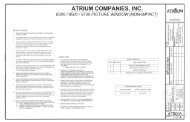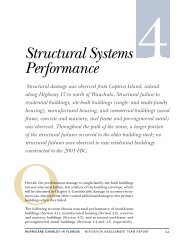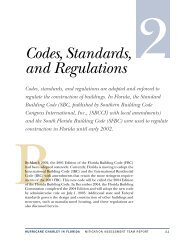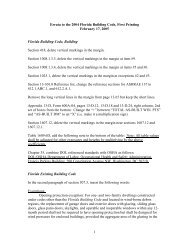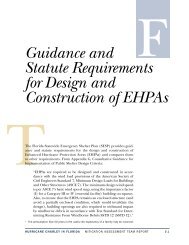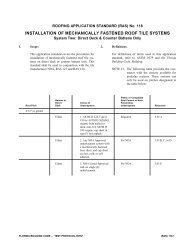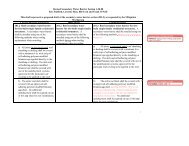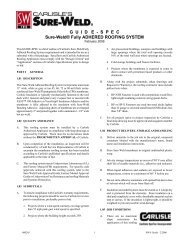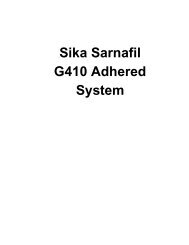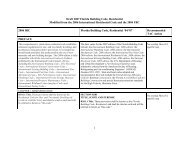EIFS Installation Handbook - Florida Building Code Information ...
EIFS Installation Handbook - Florida Building Code Information ...
EIFS Installation Handbook - Florida Building Code Information ...
You also want an ePaper? Increase the reach of your titles
YUMPU automatically turns print PDFs into web optimized ePapers that Google loves.
Application at Corners<br />
All inside and outside corners must have two layers of mesh. This can<br />
be achieved in one of three ways:<br />
• Double wrap Sto Mesh minimum 8“ (204mm) in each direction<br />
• Apply Sto Corner Mat and overlap Sto Mesh up to the corner<br />
• Apply Sto Detail Mesh and overlap with Sto Mesh minimum<br />
8” (204mm) onto adjacent wall<br />
Application at Wall Areas<br />
Apply the Sto base coat on the insulation boards in a layer approximately<br />
1/8" (3 mm) thick. Work vertically or horizontally in strips of<br />
40” (1016mm). Immediately imbed the Sto Mesh in the wet base coat.<br />
Trowel off any excess base coat from the surface. The mesh must be<br />
fully embedded so that no mesh color is visible. Apply additional base<br />
coat if mesh color is visible when the base coat is dry. Do not butt<br />
mesh strips. Overlap the strip edges a minimum of 2-1/2" (64 mm).<br />
If the mesh is butted it will cause cracks in the base and finish coats.<br />
Feather the base coat at mesh overlaps.<br />
Application for Level 1 (Ultra High) Impact Areas<br />
Sto EIF Systems are engineered wall cladding systems and can be<br />
enhanced in several ways to accommodate higher impact needs.<br />
Where additional impact resistance is required, such as on ground<br />
floors, garage areas, and areas accessible to pedestrian traffic, Sto<br />
recommends the use of Sto Armor Mat to a minimum height of 6’-0”<br />
(1.8m). First apply a base coat layer and imbed Sto Armor Mat (ultrahigh<br />
impact mesh). When using Sto Armor Mat, the edges must be<br />
butted, not overlapped, due to the thickness of the mesh. After this<br />
application has dried, apply the base coat with regular Sto Mesh as<br />
previously described.<br />
Drying before Finish Application<br />
IMPORTANT: All EPS boards are to be covered with the base coat<br />
and mesh application and allowed to dry prior to applying any finish.<br />
Primer Application (Optional System Component)<br />
Priming is recommended as a color base for Stolit ® R finishes, or fine<br />
aggregate finishes such as .75 mm or 1 mm finishes. If Sto RFP base<br />
coat is tinted to the same shade as the finish, the primer is not<br />
necessary. In addition, priming provides uniform substrate absorption,<br />
enhances finish color and inhibits efflorescence in cementitious substrates.<br />
The primer is applied with a paint roller or brush to the substrate.<br />
Certain finishes, Sto Decocoat and Sto GraniTex, always require<br />
the base coat to be primed.<br />
Finish Application<br />
Plan the finish application so enough workers are available to finish<br />
entire sections of wall area at one time without interruption.<br />
Mix the finish with a clean, rust-free mixer. Small amounts of clean<br />
water may be added to aid workability. Limit water to amount needed<br />
to achieve the finish texture. Use only stainless steel trowels to apply<br />
the finish. Work in pairs with the first person applying the finish to the<br />
wall, and the second person floating the finish to the proper texture<br />
(refer to page 20 for “floating textures”).<br />
By following the guidelines listed below and shown in the adjacent<br />
pictures, problems can be prevented and an aesthetically pleasing wall<br />
surface will be the result:<br />
1. Apply finish directly over the base coat (or primed base coat as specified)<br />
ONLY AFTER THE BASE COAT/PRIMER HAS THOROUGHLY DRIED.<br />
24 hours minimum drying time is recommended. If cool and/or damp<br />
conditions exist, allow additional drying time, minimum 72 hours.<br />
2. Avoid application in direct sunlight. This can cause shadow lines<br />
from scaffolding.<br />
18 19



